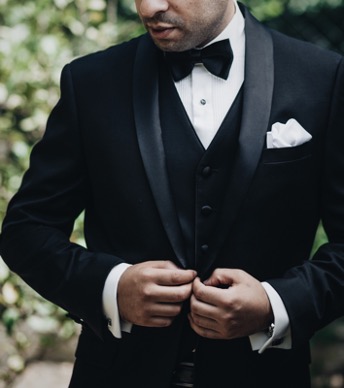A bow tie is usually fitting for any of your tie related occasions. You wear it in formal, semi-formal, and even in some casual settings. But remember that this fashion trick is not easily carried out. Wearing a bow tie shows one’s confidence, by making a statement that you’re not afraid to be the center of attention in a crowd. Wearing a bow tie means that you’re going the extra mile to look as stylish as possible in your outfit.
Formal
Black tie events are the second most common setting after weddings where you can see bow ties in their magnificent form yet such events are usually scarce. The black tie dress code is consists of a dinner jacket (tuxedo) and a black bow tie. A white tie event, also known as “full dress,” is yet another step up in formality–it’s the highest point capable of formal dress. As the name suggests, a white bow tie is necessary.
Semi Formal
While the phrase “semi-formal” can be irritating, any affair called one is a marvelous occasion for experimentation with bow ties. It isn’t recommended to take too many risks here either, though. It’s better to lean towards formal dressing than lean towards semi formal. By all means, enjoy your variety of options when it comes to bow tie styles, materials, and textures, but aim to remain within the limits of the dress code.
Bu gönderiyi Instagram’da gör
Casual
As the name suggests, you are free to write your own rules. Go nuts, experiment, see what you like and what works for you.
Bu gönderiyi Instagram’da gör
Where to wear a bowtie: The general rule about when to wear a bow tie is this: If the event or setting is suitable for neckties, then it is suitable for bow ties. Venues for recitals, ballets, and performances of this sort do not usually have dress codes. Since many people seem to associate bow ties with connoisseurs and scholars, it seems fitting to wear a bow tie when enjoying the delicacies of viniculture. Now and then one should do brunch, and one should dress for brunch. Wearing a bow tie to a high-end brunch in a nice venue elevates everyone and everything lucky enough to be around you.
When Not to Wear a Bow Tie: There are better and worse events for a bow tie, but there is no general rule about when or where not to wear a bow tie. The question ”When should I not wear a bow tie?” does come up, however, and so here is our advice:
- If the occasion is fitting for neckties, then it is fitting for bow ties..
- If a necktie is too formal for an occasion, then a bow tie might also be too formal. It is possible to downplay a necktie more easily than it is a bow tie. If the event is casual and the key phrase in the dress code is “don’t dress-up,” then a necktie with a slack knot can be part of a fashionably-assembled but still carefree and relaxed look. Even the most casual bow tie requires you to have the top button of your shirt buttoned, and while that isn’t necessarily overdressing, it is not a relaxed one.
- If the point of a specific dress code is to ensure uniformity or homogeneity – like a group photo – and the dress code requires ties to be worn, then you can assume the dress code is asking for neckties. If a bow tie would not be in keeping with the general guidelines of the code, then it would be inappropriate.
HOW TO TIE A BOWTIE
You don’t have to know how to tie a bow tie until you do, and by then it’s too late. If you are a beginner and have no clue how to handle a self tie bow tie, below you can see how to go about it. It does take some time to do it right, so be patient. If the steps below aren’t enough, go online and find an instructional video, whichever suits you best.
Step 1: Start by positioning the bow tie around your neck so that one end is a few inches longer than the other.
Step 2: Cross the long end over the shorter end.
Step 3: Pull the longer end back up and under the shorter end and tighten to your neck.
*It’s important to note that you won’t be able to adjust the tightness of the knot of your bow tie like you do with a necktie after this knot is secured, so be sure this knot is properly adjusted.
Step 4: Leaving the long end out of the way, form the bow shape with the shorter end of the tie.
Step 5: Let the longer end fall over top of the center of the bow you just formed.
Step 6: Fold the remaining part from the long end of the tie into a bow shape that roughly matches the bow you’ve formed.
Step 7: Slip the long end bow through the space between the short end bow and the knot against your neck.
Step 8: Tighten the bow by pulling both ends of the tie at the same time with equal force.
Step 9: Even out the tie and adjust the ends by carefully pulling the ends of the bow horizontally.
Step 10: Admire your work.
The “How to Tie a Bow Tie” segment above was taken from the link below:
https://blacklapel.com/thecompass/how-to-tie-a-bow-tie/

